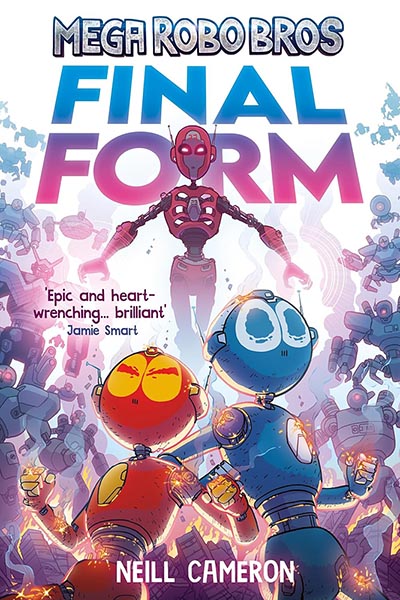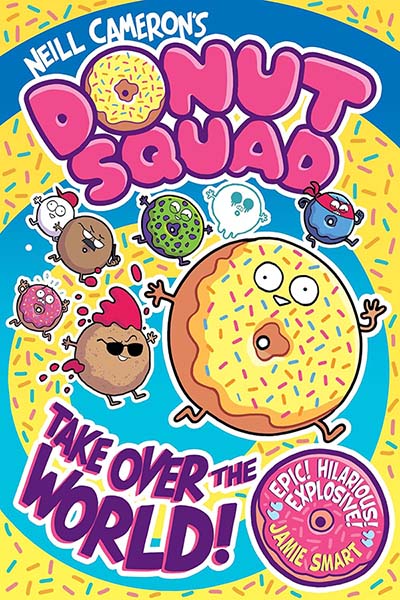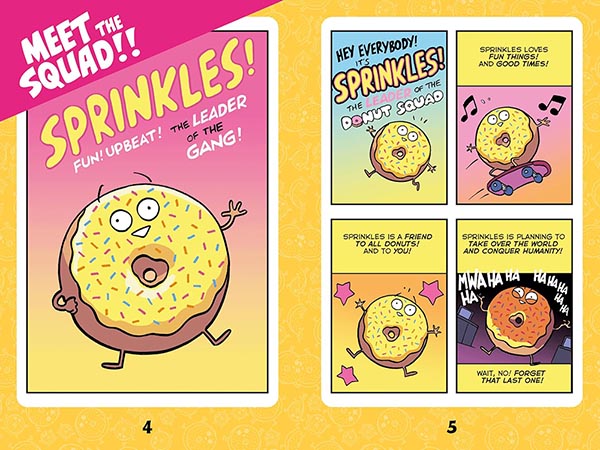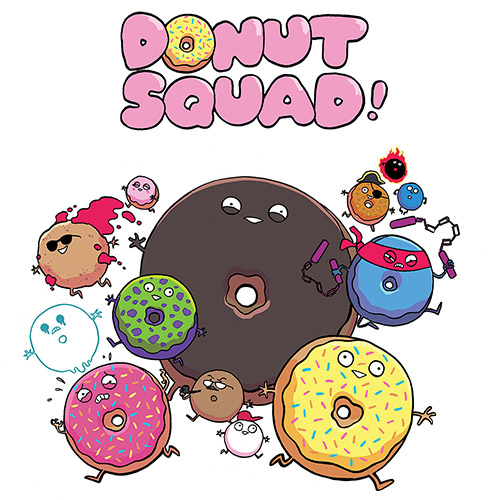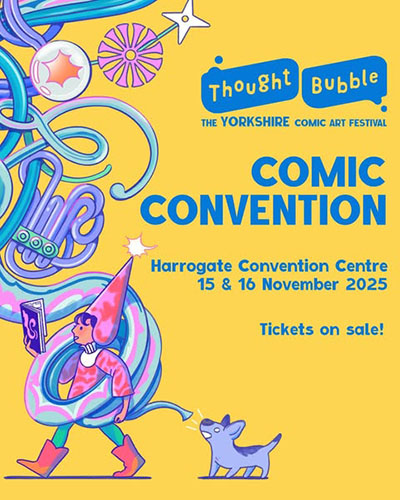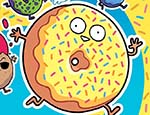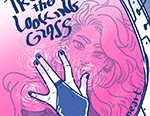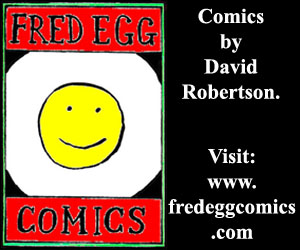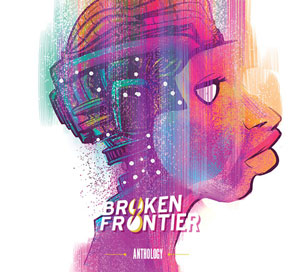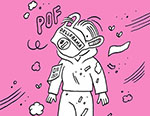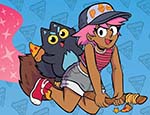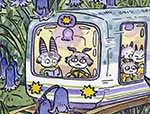THOUGHT BUBBLE MONTH 2025! Neill Cameron’s Donut Squad has become one of the absolute highlights of UK kids weekly comic The Phoenix in recent months. I described it here at Broken Frontier as “a frantic, mischievous, form-pushing delight” when I reviewed its first outing in book form over the summer. Cameron is also responsible for long-running The Phoenix mainstay Mega Robo Bros (“Alex and Freddy are two normal bickering brothers – who also happen to be super-powered robots!”) and the strip The Villinoos (“set in the far future, in which humanity is locked in an eternal space war with the Villinoos, a race of spiky purple evil aliens”) which he collaborates on with his son Logan.
With The Phoenix having another booked-out presence at Thought Bubble what better time to catch up with Neill and get the lowdown on all his wonderful all-ages creations? We chatted about saying goodbye to the Mega Robo Bros, the frenetic lives of the Donut Squad, and getting comics into the hands of younger readers…
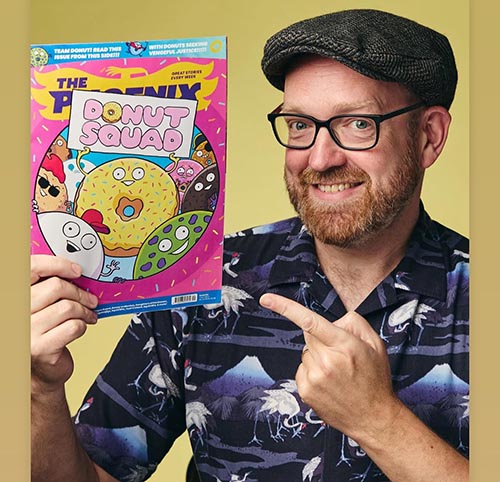
ANDY OLIVER: It’s not that long since your long-running Mega Robo Bros strip reached its finale in The Phoenix. How does it feel to come to the end of that storytelling journey and see so many collected volumes out there on the shelves? Do you already miss the characters given that they had been such a big part of your life for so long?
NEILL CAMERON: I do! It’s weird, because I came to the end of this series, this decade-long undertaking that had meant so much to me and been such a big part of my brain for so long, and then very shortly afterwards the first Donut Squad book came out and I had to kind of jump straight over, full steam ahead, onto that. Didn’t have time to mourn! Which is probably for the best, honestly. I am still kind of talking about Mega Robo Bros when I do events, and doing lots of sketches of Alex and Freddy at signings and stuff, and it makes me very happy every time I do. I love my good (fictional) robot kids! Seeing a child come up at a signing with big and clearly very well-read stack of MRB books really is just about my favourite thing in the world.
AO: What was the genesis of Donut Squad? How did the idea for the multiple strips evolve and change as you began devising the characters and situations?
CAMERON: I wish I had a better anecdote for the genesis of it, but one day the basic idea for the strip, the kind of tone and vibe of it, just popped into my head and I made myself laugh. The way I’ve come to see it is that I think all the stress of ending Mega Robo Bros, all that pressure to stick the landing, and do justice to those characters; to deliver a satisfying ending for the readers who cared about them, who’d been invested in them for years, just kind of… broke my brain? My brain broke, and out came donuts.
And then, yeah, all the variations on it come from that sort of ongoing tension between the readers’ desire to kind of see the characters they love and have them say their regular catchphrase or do their schtick or whatever, and my desire to just keep fiddling with it to keep it fun for myself. There’s a lot of value to repetition with this kind of thing; kids (and indeed adults) love to see the thing they already know and love, so it’s then a constant game of giving them that but also playing around and messing with those expectations.
Like, kids know that if it’s a Jammyboi strip, then Jammyboi is going to turn up at the end and get jam on things. But what if he doesn’t ? What happens then? What happens to a gag strip if the punchline never arrives? How long can you hold off that moment of release, and what ridiculous lengths can you take the story to in trying to avoid it? I think these kind of things can be very fun.
AO: The overwhelming success of Donut Squad in The Phoenix must be a great thrill for you. What have been some of the most memorable responses/interactions from your readers in regards to the strip?
CAMERON: Oh my goodness. So many, too many to know where to start. The entire family who came along to Thought Bubble last year all dressed up as their favourite donuts was pretty hard to beat. Or the other week, I was at the Story Museum in Oxford, where I run regular Comics Club groups for kids. After the session this nice woman came up to me and said hello, and pointed over at this adorable tiny child hiding under a table on the other side of the courtyard, and said “that’s my daughter, and she’s too nervous to come and talk to you, but I wanted you to know that she loves Sweetum (one of the characters from Donut Squad) so much, she reads the book over and over, and she sleeps every night with the book, open to Sweetum’s page, under her pillow, so that she will have sweet dreams.”
I mean, what do you even say to that? I still have no idea how to even respond to it. Other than to think, wow, I should really put Sweetum in the comic more! They were like a one-off throwaway gag character, and now they are this one reader’s, like… spirit totem? Emotional support donut? So now I feel a weird pressure to come up with more Sweetum strips, for the sake of that kid!
AO: One of the things I love most about Donut Squad is the way in which it can be read by younger people and adults on different levels. The recent Waiting for Godot parodies are a good example in that kids will just see the humour but older readers will take the cultural references in another way. Is that a conscious decision to give something for all readers, especially if they’re reading together as a family?
CAMERON: I think that’s a happy side effect of it, and I really love that parents enjoy it as much as their kids, and they get to kind of share it as a family. But it really just comes about from me finding stuff to make myself laugh. I have to have six – actually, now seven – funny ideas a week for this thing, so at this point pretty much whatever I’m thinking about is going to go through the filter and come out as donuts. I went to see Waiting For Godot for the first time recently, and I… had a lot of thoughts about it afterwards, and apparently my way of processing those thoughts is to turn them into comics about donuts.
A thing I’ve really learned doing this is that different readers can respond to things, and find things funny, on different levels, and those levels are completely equally valid. So I’m not expecting any child who reads it, ever, to go ‘oh, how droll, a Beckett reference’. They can just read it and go ‘this is just incredibly weird and random and kind of dark that these two donuts are standing there waiting for this guy forever, and he never comes, and sometimes they freak out and pull silly faces, and that is funny’. I think in this case the kind of starkness and absurdity of the play, and its frankly aggressive trolling of an audience’s expectations, actually converts really well to a 4-panel gag strip about donuts. I’ve just come back from the Lakes festival, where I had a room full of kids shouting at me and demanding to know if Godonut would ever show up, and telling me their theories about who he might be. Absolute madness.
AO: We’re often told that kids aren’t into comics anymore but the success of The Phoenix shows that’s patently untrue. Do you have any thoughts on how we continue to move forward with championing the form to younger readers in an age where the traditional newsagent model of delivery is pretty much a thing of the past?
CAMERON: Yeah, it’s tricky: we’ve definitely moved to a situation where kids’ primary access to comics has shifted from the newsagent to the bookshop or library. So there’s the challenge on the one hand of how do we make sure all kids are getting access to comics, and not just the pool of kids who are regularly able to use those spaces. And a lot of that is maybe beyond our remit as a community and more to do with wider challenges like ‘making sure schools actually have libraries, and funding them properly, and valuing literacy as a society’, stuff like that.
But also from a publishing point of view, there’s the challenge of how you make this shift from periodicals to books work. The Phoenix has seen such incredible success – with Jamie’s work on Bunny VS Monkey in particular, a genuine publishing phenomenon – in the last few years, and I think we’re now seeing other publishers take note and take an interest in making graphic novels for kids. But I think what people maybe sometimes don’t appreciate is the huge time and resource investment that went into making that phenomenon possible. Publishing The Phoenix, every week, for years – and through long years when the general opinion was this this was a weird, quixotic undertaking – and investing in artists and their stories on that scale. Investing in huge amounts of material that maybe *aren’t* going to blow up and be as big as BVM. That might never be collected as books at all. Because doing that lets you find the one that *does*. Giving artists the room to experiment, to grow, to develop as creators, and find their voices, and build an audience and a career. That’s what we need publishers to be doing, and I think it’s a lot harder without that weekly model, that chance to try things out and see what works; if you go straight to a whole graphic novel and it’s not a hit out of a gate, does the creator get that second chance?
Please note I do not have any useful answers here, these are just the kind of questions that I think about when it comes to more publishers and a new generation of creators entering this space, even as it’s all changing so rapidly.
AO: Can you tell us about some of your wider activities in the comics community including your comics club for kids, exhibition curation, workshops and your time as artist-in-residence at the Story Museum?
CAMERON: Again, so many things! I’ve been working with the Story Museum for years now, where I’ve done all sorts from helping design installations, producing large-scale comics murals and stuff, to drawing the signs on the toilet doors. It’s such a brilliant, mad and unique place, and I am very grateful for whatever happy accident put me on their radar in the first place. A couple of years ago I got to curate an exhibition for them which was focussed on encouraging kids to make their own comics, but also drew together strands from all across the history of British comics to do so. What was lovely about that one was that I got to collaborate, not just with my usual gang at the Phoenix, but with the guys from the Beano and Rebellion as well, so I really got to play with all the toys in the British Comics box. I got to draw Judge Dredd* chasing down Dennis the Menace**! How many people get to say that?
* technically Cadet Dredd
** technically just Dennis, no Menace. I did read the brand guidelines, I promise! DILIGENTLY.
And the comics club groups I run there – I’ve been doing that for years now, and it’s become one of my favourite things I do. Just that I get to see this gang of comics-obsessed little maniacs every month, over years and years sometimes, it’s so fun. They can kind of be my little focus group, and I’m sure that seeing the kind of things they find funny – and also, conversely, how funny they find it to wind me up, and vice versa – has completely informed the kind of comics I make these days with Donut Squad. But also, it’s just so great that these kids have a place to come and just be themselves and be completely into this thing they are into, with a whole room of people who are completely into it too. I never really had that when I was young, and I am enormously glad that I get to be a part of giving that to others.

AO: And, finally, what next for Neill Cameron? Are there any new projects for 2026 you can tell us about?
Just lots more of the same stuff really! As much new Donut Squad as I am physically capable of drawing. And I’m currently working on a new series of The Villinoos, the new series that we do for The Phoenix, that I draw and my son Logan writes, which is just a whole other world of mad ridiculous fun in itself. I always used to joke that with all the workshops and stuff, I was always training up my own replacements, and now with Logan this joke has become alarmingly, delightfully literal.
Interview by Andy Oliver
Visit Neill Cameron’s website and online store here
Neill Cameron and The Phoenix will be at Tables K1-5 in the Kids Zone in Bubbleboy Hall at Thought Bubble.
Thought Bubble 2025 runs from November 1oth-16th with the convention weekend taking place on the 15th-16th. More details on the Thought Bubble site here.
Read all our Thought Bubble 2025 coverage so far in one place here.
Poster by Ng Yin Shian






